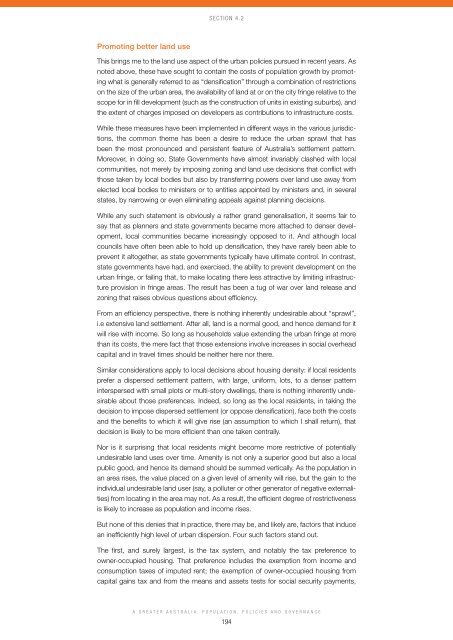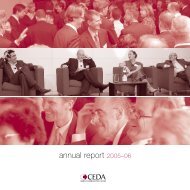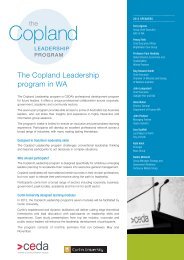Section 4.2Figure 2Average annual CPI growth in <strong>Australia</strong>1816Electricity14Water <strong>and</strong> sewerage1210Gas & other fuels864Total CPI (all groups)202005 2006 2007 2008 2009 2010 2011Source: <strong>Australia</strong>n Bureau of Statistics, 6401.0, Dec-2011size <strong>and</strong> periodicity, the absence of alternatives, <strong>and</strong> the extreme consequences ofdisconnection – making the pain associated with such sustained, on-going increasesall the more acute.High consumer sensitivity has also attached to the transport system, though withaccess largely either not priced (as for most roads) or heavily subsidised (as with publictransport), the form the problems take differs. Rather than involving direct monetaryoutlays, the consumer cost comes mainly in the form of degradation in service quality,most notably congestion. And the perception has been that these costs have increased:on the roads, with somewhat slower traffic speeds at peak <strong>and</strong> the peaks themselveslasting longer; <strong>and</strong> on public transport, with greater crowding <strong>and</strong> some reduction inservice availability.While estimates of these costs are controversial, it is difficult to deny that there areindeed areas of severe congestion in the <strong>Australia</strong>n transport system. For example,Sydney’s Eastern Distributor (the M1), the M5 East Motorway <strong>and</strong> the Concord toLapstone section of the Western Distributor (the M4), are all congested 13 or morehours a day. Moreover, most of the main Sydney links – the harbour crossings, the M5<strong>and</strong> the M5 East, Southern Cross Drive <strong>and</strong> the M7 – average over 20,000 vehicles perlane daily, which is close to or exceeds theoretical carrying limits, <strong>and</strong> other major links(such as the Eastern Distributor, the M2 <strong>and</strong> the M4) are not far behind. Yet projections(again, controversial) are that traffic on the M5 will double by 2031, while traffic generallyin the Sydney area will rise by around 80 per cent. Similar accounts could be givenfor at least Brisbane <strong>and</strong> Melbourne, with the latter also suffering congestion issues onparts of its public transport network.There is, as a result, an impression that here too the “squeezing of the lemon” hasreached its limits, or will soon do so: with consequent pressures for increased outlays.The obvious question this raises is the extent to which these scarce resources – be it ofutility infrastructure or of transport links – have been provided <strong>and</strong> used efficiently. Butputting that efficiency question aside for a moment, what is nonetheless clear is that ifthe intention was to avoid increased outlays by reshaping settlement patterns, that goalhas not been achieved or at least, has only been achieved to a modest extent.A <strong>Greater</strong> <strong>Australia</strong>: <strong>Population</strong>, Policies <strong>and</strong> Governance193
Section 4.2Promoting better l<strong>and</strong> useThis brings me to the l<strong>and</strong> use aspect of the urban <strong>policies</strong> pursued in recent years. Asnoted above, these have sought to contain the costs of population growth by promotingwhat is generally referred to as “densification” through a combination of restrictionson the size of the urban area, the availability of l<strong>and</strong> at or on the city fringe relative to thescope for in fill development (such as the construction of units in existing suburbs), <strong>and</strong>the extent of charges imposed on developers as contributions to infrastructure costs.While these measures have been implemented in different ways in the various jurisdictions,the common theme has been a desire to reduce the urban sprawl that hasbeen the most pronounced <strong>and</strong> persistent feature of <strong>Australia</strong>’s settlement pattern.Moreover, in doing so, State Governments have almost invariably clashed with localcommunities, not merely by imposing zoning <strong>and</strong> l<strong>and</strong> use decisions that conflict withthose taken by local bodies but also by transferring powers over l<strong>and</strong> use away fromelected local bodies to ministers or to entities appointed by ministers <strong>and</strong>, in severalstates, by narrowing or even eliminating appeals against planning decisions.While any such statement is obviously a rather gr<strong>and</strong> generalisation, it seems fair tosay that as planners <strong>and</strong> state governments became more attached to denser development,local communities became increasingly opposed to it. And although localcouncils have often been able to hold up densification, they have rarely been able toprevent it altogether, as state governments typically have ultimate control. In contrast,state governments have had, <strong>and</strong> exercised, the ability to prevent development on theurban fringe, or failing that, to make locating there less attractive by limiting infrastructureprovision in fringe areas. The result has been a tug of war over l<strong>and</strong> release <strong>and</strong>zoning that raises obvious questions about efficiency.From an efficiency perspective, there is nothing inherently undesirable about “sprawl”,i.e extensive l<strong>and</strong> settlement. After all, l<strong>and</strong> is a normal good, <strong>and</strong> hence dem<strong>and</strong> for itwill rise with income. So long as households value extending the urban fringe at morethan its costs, the mere fact that those extensions involve increases in social overheadcapital <strong>and</strong> in travel times should be neither here nor there.Similar considerations apply to local decisions about housing density: if local residentsprefer a dispersed settlement pattern, with large, uniform, lots, to a denser patterninterspersed with small plots or multi-story dwellings, there is nothing inherently undesirableabout those preferences. Indeed, so long as the local residents, in taking thedecision to impose dispersed settlement (or oppose densification), face both the costs<strong>and</strong> the benefits to which it will give rise (an assumption to which I shall return), thatdecision is likely to be more efficient than one taken centrally.Nor is it surprising that local residents might become more restrictive of potentiallyundesirable l<strong>and</strong> uses over time. Amenity is not only a superior good but also a localpublic good, <strong>and</strong> hence its dem<strong>and</strong> should be summed vertically. As the population inan area rises, the value placed on a given level of amenity will rise, but the gain to theindividual undesirable l<strong>and</strong> user (say, a polluter or other generator of negative externalities)from locating in the area may not. As a result, the efficient degree of restrictivenessis likely to increase as population <strong>and</strong> income rises.But none of this denies that in practice, there may be, <strong>and</strong> likely are, factors that inducean inefficiently high level of urban dispersion. Four such factors st<strong>and</strong> out.The first, <strong>and</strong> surely largest, is the tax system, <strong>and</strong> notably the tax preference toowner-occupied housing. That preference includes the exemption from income <strong>and</strong>consumption taxes of imputed rent; the exemption of owner-occupied housing fromcapital gains tax <strong>and</strong> from the means <strong>and</strong> assets tests for social security payments,A <strong>Greater</strong> <strong>Australia</strong>: <strong>Population</strong>, Policies <strong>and</strong> Governance194
- Page 2 and 3:
A Greater Australia:Population, pol
- Page 4 and 5:
ContentsForeword CEDA Chief Executi
- Page 6 and 7:
ForewordIt is with pleasure that I
- Page 8 and 9:
IntroductionResponding to the resul
- Page 10 and 11:
IntroductionA more dynamic and vita
- Page 12 and 13:
IntroductionSustainabilityConcern a
- Page 14 and 15:
IntroductionThe new demographics, h
- Page 16 and 17:
Section 1.0Historical perspectives1
- Page 18 and 19:
Section 1.1IntroductionJapan’s cr
- Page 20 and 21:
Section 1.1Figure 1Forecast number
- Page 22 and 23:
Section 1.1Table 1Defence spending
- Page 24 and 25:
Section 1.1How much defence is enou
- Page 26 and 27:
Section 1.1ConclusionA substantial
- Page 28 and 29:
Section 1.2There has been over a ce
- Page 30 and 31:
Section 1.2Resource constraints wer
- Page 32 and 33:
Section 1.2Similarly, in the 1994 H
- Page 34 and 35:
Section 1.2ReferencesAustralia, Dep
- Page 36 and 37:
Section 1.3IntroductionAustralia is
- Page 38 and 39:
Section 1.3The grey 90sThe heady ex
- Page 40 and 41:
Section 1.3Taylor’s stony rebutta
- Page 42 and 43:
Section 1.3Figure 1The Benhamite Op
- Page 44 and 45:
Section 1.3In mathematical terms, t
- Page 46 and 47:
Section 1.3characterisation of the
- Page 48 and 49:
Section 1.3ConclusionA retrospectiv
- Page 50 and 51:
Section 2.0Population futures2.1 Fo
- Page 52 and 53:
Section 2.1Conventional population
- Page 54 and 55:
Section 2.1It is more useful for go
- Page 56 and 57:
Section 2.1Forecasting of births, w
- Page 58 and 59:
Section 2.1Future net overseas migr
- Page 60 and 61:
Section 2.13). This had a lot to do
- Page 62 and 63:
Section 2.2IntroductionIn late Sept
- Page 64 and 65:
Section 2.2Figure 1The migrant cont
- Page 66 and 67:
Section 2.2The visa and residency s
- Page 68 and 69:
Section 2.2sponsorship, subject to
- Page 70 and 71:
Section 2.2Figure 3Historical and p
- Page 72 and 73:
Section 2.2The views in this chapte
- Page 74 and 75:
Section 2.3IntroductionThe Australi
- Page 76 and 77:
Section 2.3Figure 3Australia: Distr
- Page 78 and 79:
Section 2.3Table 2Australia: Popula
- Page 80 and 81:
Section 2.3Table 4Views of Australi
- Page 82 and 83:
Section 2.3Table 5Australian States
- Page 84 and 85:
Section 2.3A number of hypotheses h
- Page 86 and 87:
Section 2.3Table 8Australia: Distri
- Page 88 and 89:
Section 2.3Table 10Non-Metropolitan
- Page 90 and 91:
Section 2.3Policy issuesThe configu
- Page 92 and 93:
Section 2.3Climate change is likely
- Page 94 and 95:
Section 2.3ConclusionAny realistic
- Page 96 and 97:
Section 2.340 Swan, W., 2010.Austra
- Page 98 and 99:
Section 2.4IntroductionThe Australi
- Page 100 and 101:
Section 2.4At present there is a hi
- Page 102 and 103:
Section 2.4innovation initiatives w
- Page 104 and 105:
Section 2.4Endnotes1 Henry, K 2009,
- Page 106 and 107:
Section 2.5IntroductionAustralia is
- Page 108 and 109:
Section 2.5else. Even with a broad
- Page 110 and 111:
Section 2.5commercially viable - th
- Page 112 and 113:
Section 2.5A vast country like Aust
- Page 114 and 115:
Section 3.0Society and the individu
- Page 116 and 117:
Section 3.1Extent of public opinion
- Page 119 and 120:
Section 3.1category immigrant/forei
- Page 121 and 122:
Section 3.1The Environics Research
- Page 123 and 124:
Section 3.1Per cent100908070Figure
- Page 125 and 126:
Section 3.1A number of surveys soug
- Page 127 and 128:
Section 3.1Table 8Percentage who an
- Page 129 and 130:
Section 3.1A more precise indicatio
- Page 131 and 132:
Section 3.1The strongest predictor
- Page 133 and 134:
Section 3.1Endnotes1. There is also
- Page 135 and 136:
3.2Social inclusion and multicultur
- Page 137 and 138:
Section 3.2a broader definition of
- Page 139 and 140:
Section 3.2Figure 1Estimated povert
- Page 141 and 142:
Section 3.2Table 2Visa Type of Sett
- Page 143 and 144: Section 3.2Table 5First Generation
- Page 145 and 146: Section 3.2Table 6Australia: First
- Page 147 and 148: Section 3.2Improving outcomes for v
- Page 149 and 150: Section 3.2increasing diversity of
- Page 151 and 152: 3.3Linkages between education and p
- Page 153 and 154: Section 3.3Education and productivi
- Page 155 and 156: Section 3.3In the past decade, prod
- Page 157 and 158: Section 3.3succeed in education or
- Page 159 and 160: Section 3.3case, funding also could
- Page 161 and 162: Section 3.3Endnotes1 IGR 2010: Chal
- Page 163 and 164: 3.4Healthcare delivery for our agei
- Page 165 and 166: Section 3.4• Private medical serv
- Page 167 and 168: Section 3.4the whole spectrum of in
- Page 169 and 170: Section 3.45. Experiences, pathways
- Page 171 and 172: Section 3.4Stratification of patien
- Page 173 and 174: Section 3.4Other steps include impr
- Page 175 and 176: Section 3.438 National Health Refor
- Page 177 and 178: 4.1The economic effects ofpopulatio
- Page 179 and 180: Section 4.1population growth can ex
- Page 181 and 182: Section 4.1In theory, the answer pa
- Page 183 and 184: Section 4.1Kirchner concedes that t
- Page 185 and 186: Section 4.1Endnotes1. Productivity
- Page 187 and 188: 4.2Urban infrastructure and land us
- Page 189 and 190: Section 4.2bearing the fixed costs
- Page 191 and 192: Section 4.2Figure 1Indicative dwell
- Page 193: Section 4.2Taking the electricity,
- Page 197 and 198: Section 4.2preferences to homeowner
- Page 199 and 200: Section 4.2in any Australian urban
- Page 201 and 202: Section 4.2Endnotes1 Productivity C
- Page 203 and 204: 4.3Water security:Water for the far
- Page 205 and 206: Section 4.3Water trading enables us
- Page 207 and 208: Section 4.3cent of water entitlemen
- Page 209 and 210: Section 4.3were either the full eco
- Page 211 and 212: Section 4.3Strategic opportunitiesA
- Page 213 and 214: 4.4Critiquing governmentregional de
- Page 215 and 216: Section 4.4However, there is often
- Page 217 and 218: Section 4.4Potential policy interve
- Page 219 and 220: Section 4.4Unfortunately, advocacy
- Page 221 and 222: Section 4.4contribute substantially
- Page 223 and 224: Section 4.418 Department of Educati
- Page 225 and 226: 5.1The future of population policyG
- Page 227 and 228: Section 5.1a million fewer women in
- Page 229 and 230: Section 5.1For the present, ongoing
- Page 231 and 232: Section 5.1The second worry is that
- Page 233 and 234: Section 5.1The now significantly de





